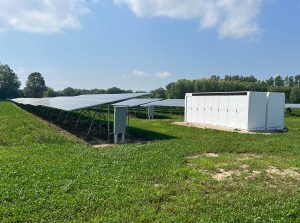The sun continues providing light into the evening for some northern Indiana residents as part of a unique project minimizing their electric bills.

The battery and solar array that are part of Fulton County REMC’s project.
Since October 2021, Fulton County REMC has partnered with a local solar array developer on a project pairing a large-scale 5 megawatt-hour battery with the array. The battery stores electricity produced by the array, which Fulton County REMC can then schedule to release, or discharge, onto the energy grid. The battery can supply power for 2 to 6 hours when fully charged. Fulton County REMC discharges the battery during the peak hours, usually between 5-8 p.m., of days when energy demand has been the highest for each month. By releasing the electricity stored in the battery, Fulton County REMC can minimize its monthly costs from Wabash Valley Power Alliance, its wholesale power provider.
“We use the battery to avoid monthly billing demand for Fulton County REMC, and we can then pass the savings onto our members,” said Andrew Horstman, CEO of Fulton County REMC. “We just set a schedule for the week and won’t run it unless we know it’s going to be a peak day. It’s a simple setup.”
Fulton County REMC can set the schedule in advance since weather is a strong indicator of energy demand, as people use air conditioning on hot days and heating during the winter, Horstman said. Cooperative staff learned how to best use the equipment in the first year. Fulton County REMC can save an average of $15,000 each month by dispatching the battery during times of peak demand.
“It has the potential to be better than the original business case,” Horstman said. “The first year was a little rough getting the hardware and software figured out. This year we’ve got a lot of that straightened out, so we are on track to do better.”
More utilities are considering battery technology, which over the past few years has become more affordable, said Matt Moore, executive vice president of power supply for Wabash Valley Power. Large-scale batteries also have become more appealing to provide greater stability as more intermittent renewable resources including solar and wind energy have been increasingly added to the nation’s energy grid, he said.
“More battery storage is coming across the country, both as standalone projects and with renewables like solar arrays,” Moore said, adding that WVPA is researching the advantages of adding battery storage to its portfolio. “Until we own and operate a battery, we won’t have the in-depth knowledge of the challenges that are associated with its operation, such as maintenance.”
Fulton County REMC plans on using the program’s results to provide more direction on pursuing additional investments in large-scale battery storage.
“This project was very innovative and cutting edge for a co-op our size, but the economics made a lot of sense,” Horstman said. “Now we’ll see if it’s worth doing more.”

